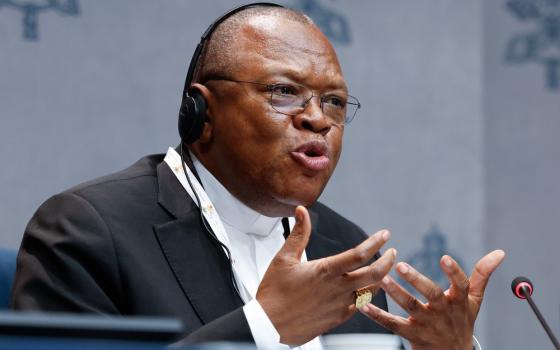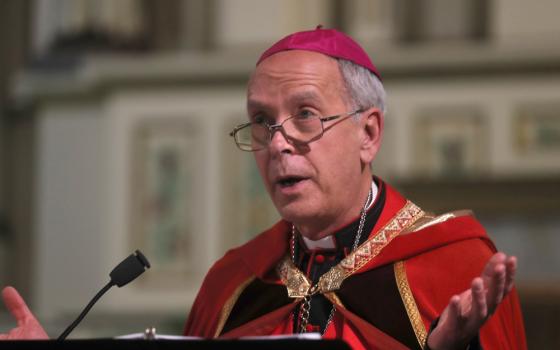Pressure for the ordination of women continues to grow in interest and intensity. You can check responses to recent NCR blogs for handy evidence. Advocates of ordination gleefully point out over and over that the time of gender equality is upon us. They show how this movement is embraced, at least in principle, in politics, education, business, government, art and every other aspect of modern society. It is perfectly obvious, they argue, that misogyny and every trace of injustice toward women must be wiped out.
And implicit in all this rhetoric lies a hard question: How then can the Roman Catholic church still bar women from the priesthood? How can it justify its position as the only institution of the Western world that still discriminates against women on principle? Yet as far as church leadership is concerned, all this talk of gender equality, regardless of its merit, is irrelevant in this case. The question of women priests has been decided infallibly by competent church authority. It is God who has spoken through his legitimate representatives. Women may of course aspire to equality in every realm of life, including certain responsible positions in the church -- except the priesthood.
I contend that that argument is dead wrong. Even a quick review of the facts reveals its flaws. And until those flaws are seen and acknowledged by the hierarchy, the church will be regarded as a stunted, impotent relic of past ages.
Back in 1994,* Pope John Paul II saw the march for women’s ordination coming and attempted to stem the tide with the document Ordinatio Sacerdotalis on the question of the Admission of Women to the Ministerial Priesthood. The pope noted that Jesus chose only men among his 12 apostles, thus establishing, he said, a binding, all-time tradition for the church that may not be challenged.
This is how the document concluded: “Wherefore in order that all doubt may be removed regarding a matter of great importance, a matter which pertains to the Church’s divine constitution itself, in virtue of Our ministry of confirming the brethren, We declare that the Church has no authority whatsoever to confer priestly ordination on women and that this judgment is to be definitively held.”
This is pretty powerful language: “in order that all doubt may be removed,” “a matter which pertains to the church’s divine constitution,” “this judgment is to be definitively held,” “we declare that the Church has no authority …”
Conservative and right-wing Catholics rejoiced that this thorny issue was finally settled, But theologians of considerable repute, including Jesuit Fr. Francis Sullivan, quickly questioned claims of infallibility. They noted that the pope did not use super-powered words like “dogma,” “supreme authority” or “infallible”. After several years of argument and controversy, it became obvious the question had not been resolved. So the Vatican backed away from the papal declaration. In 1998 the Congregation for the Doctrine of the Faith, under the direction of Cardinal Joseph Ratzinger, attempted another approach. The commentary titled Ad Tuendam Fidem acknowledged that while John Paul may not have intended to declare a dogmatic (infallible) definition in his 1994 statement, the ban on women’s ordination was nevertheless infallible since it had been set forth by the “ordinary, constant and universal” magisterium of the church.
You may want to read the previous sentence a second time. It seems that the Vatican, and especially John Paul, feared they were going too far in pinning the prohibition of women priests on one pope for all time. So they tried to preserve the main idea by associating it instead with the somewhat vague and often argued collection of doctrines that have really been “always and everywhere” taught in the church.
This move failed too, first because the CDF, though it may state its opinion, is not empowered to confer infallibility on anything. It also failed because it’s far from obvious that the ban has existed always and everywhere in the Catholic church. Historians and theologians point to the evidence of women presiders, even women bishops, at Eucharistic meals in catacomb paintings. In later centuries, there were frequent complaints by bishops that women were still acting as presiders in some places, and demands were made that the practice should cease – an indication the practice had not been quickly or easily squelched. And now in modern times we have a period of nearly 50 years (from the 1960s to the present) when the church -- that is, the laity -- are showing determined support for women’s ordination.
When Pope Francis was asked about the issue, he brushed off the question, saying John Paul settled the matter and the door is closed. Yes, it is. But it should be clear by now that it wouldn’t take an ecumenical council or a new Reformation to re-open it.
*An earlier version of this post referred incorrectly to a different document and year.


